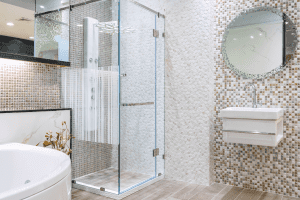Most internal doors open into the area that it covers. But in the case of pantry doors, does the same rule apply? We did some research on whether pantry doors should open in or out, and here is what we found out.
In the case of small pantries, it makes more sense to have the door swing out to maximize storage space and access, while the opposite may be the case for larger walk-in-type pantries. Though there is no hard and fast rule, how the pantry is designed determines which direction the door will open.
If you still have some questions about how a pantry door should open, don't worry. In this post, we'll discuss the topic in greater detail. We'll talk about the three basic pantry configurations and how they affect which way the door opens and more. Without further ado, let's get into it.

What Are The Three Basic Pantry Configurations?
Pantries that we know nowadays have either a reach-in, pull-out, or walk-in design. Whatever the design, it follows the fundamental premise that the pantry should be located no more than 3 feet away from where you prepare your food.
It's also essential that for a fully functioning, efficient kitchen, the pantry design should be well incorporated into the initial considerations and not merely as an afterthought.

Reach-In Pantry
In cases of smaller kitchens, the reach-in configuration may be the most logical choice. A classic example is a bat-wing type, where a shallow cabinet stores a minimum of a week’s supply of dry goods.
The more oversized items are stored inside, while smaller items may find their place on the shelves attached to the inner side of the door. In this case, the doors tend to swing out.
A reach-in pantry is the most convenient configuration, as it strategically places items used in a well-coordinated manner.
The ideal reach-in pantry is shallow, usually no more than 16 inches in diameter. Anything deeper than this would need a roll-out tray so that no item is hidden behind or beneath something stored.
It is also relatively inexpensive to build, as standard factory kitchen cabinets may be employed and do not require any special hardware. But you may need to invest in heavy-duty hinges, especially if you decide to place small shelves on the door.
Pull-Out Pantry
In midsized kitchens where you may be able to afford some degree of depth but not much horizontal space, then a pull-out type of pantry may be acceptable. Imagine a shelf that is placed sideways, sitting on sturdy, expensive hardware that you pull towards you.
It has visibility and accessibility on both sides for whatever dry goods that you store. In this case, the door swing direction is not much of a concern since you just pull it out.
A pull-out type is not as convenient to use as the bat-wing type, as pulling the shelf-turned-drawer is a bit heavy and more expensive to build. Although for small kitchens where space is a premium, a variation of the pull-out type may be adapted.
Walk-In Pantry
Larger kitchens may provide a space that allows the walk-in type where the door usually opens or swings in. A walk-in pantry is a small room adjacent to the kitchen, much like a larder that functioned in the olden days.
This configuration affords more storage area for condiments, spices, and other ingredients regularly used in the cooking process. However, it would be cumbersome to go back and forth, as it breaks the basic pantry rule—it should be no more than 3 feet away.
A somewhat variation to a walk-in pantry is a walk-through type where the storage space is linked across the walls that connect the kitchen to another area of the house like the garage or back door or living spaces.
More than storage, it serves as an access aisle. The shelves may be left open or closed off with regular cabinet doors.
Does It Matter If A Door Opens In Or Out?
So again, the direction a door opens can add to the efficiency of your pantry. The goal is to maximize the use of all available space, allowing ease of access when getting supplies and making everything visible.
Does A Pantry Need A Door?

The overall look and feel of your kitchen plus your choice of pantry configuration determine if a door is necessary. An open concept kitchen may allow a pantry not to have doors. Reach-in and walk-in pantries may be better with a door.
The pull-out type pantry will have the door firmly attached to the front panel. Walk-through pantries may be best to have a door to hide the shelving.
How Wide Should A Pantry Door Be?
The width of the pantry door depends on the style and design that you would like to install for your pantry. It can range from 24 to 36 inches. It can also be affected by the size of the pantry.
The standard aisle for a pantry is 44 inches. In case you have shelving on one side, this can extend to 60 inches. Add another 10 inches to make it 70 inches if you decide to have shelves on both sides.
How Do You Cover A Pantry Without A Door?
We have listed below some creative ways to cover a pantry without a door:
- Place a curtain either in the form of beads, bamboo mats, or decorative cloth over the doorway.
- Install glass doors or panels to the shelves to break the visual clutter if you would like your pantry to have a continuous flow in your kitchen.
- Alternatively, if the space allows for a glass sliding door, then you can opt for this. But make sure to leave markings on the glass door or frost it to inform people of the presence of glass in the opening.
- Use folding screens or room dividers to block the pantry when you’re not using it. You can easily remove it when you start working in the kitchen.
- You can place a small table before the pantry to block the view of the lower portion if you don’t want it exposed. The small table can also serve as a landing for groceries that you need to stock.
How Do You Make A Pantry Door Look Good?
Here are ways to add character to your pantry doors:
- Use wood, antique, French, or Dutch doors to create the look and feel you want.
- Consider incorporating clear or frosted glass to allow natural light, thereby creating an illusion of a bigger space.
- You can also use chicken wire mesh or screen instead of glass if the kitchen has an industrial or country vibe.
- You may opt for a sliding door or barn door style for a walk-in pantry.
- Hang a chalkboard outside the pantry door or paint the door with chalk paint. You can use the chalkboard to list ingredients running low and snap a photo with your phone before you step out for groceries.
- Hang signs or labels on the pantry door.
- Choose to paint your doors distinct from your kitchen motif to make the pantry door stand out.
- Adopt a glass panel design to add more vibrant colors or quirky design to your pantry door.
- Maximize access and minimize clearance by installing a bifold door.
- Add texture to your door through commercially bought designs or DIY using your favorite items.
- Instead of sticking your travel magnets on your refrigerator, use your pantry door instead.
- Attach pantry door organizers.
- Don’t stick to the usual rectangular doors. You can opt for a rounded top, which may be all solid or paneled.
Click here to see this pantry wood sign farmhouse decor on Amazon.
In Closing
The design and function intended for the pantry determine which direction the door swings—either in or out. Unlike other parts of the house, pantry doors are more flexible.
There are no hard and fast rules, only that for a pantry to be effective, it must be adjacent to the area where food preparation occurs. Otherwise, even if you have a well-planned pantry, it may not be a well-functioning one.
If you’re are also wondering whether other doors in the house should open in or out, please click on the links below:




